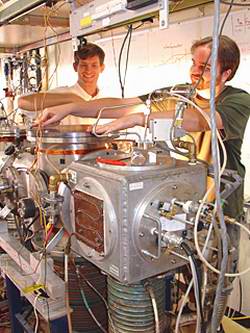Science Fiction
Dictionary
A B C D E F G H I J K L M N O P Q R S T U V W X Y Z
Lower Limit For Nanobot Size Discovered

Size limits for nanotechnology devices have finally been determined by University of Arizona physicists, who have succeeded in directly measuring how close an atom can come to a surface before its wave changes. This is the first time that the idea that a fast-moving atom's wave shortens and lengthens, depending on its distance from a surface. This idea was first proposed in the late 1920's.
This measurement is essential information for nanotechnologists, because it limits how small a device can be before van der Waals forces between atoms and surfaces starts to become a problem for a working device.

(From Atom interferometer)
UA optical sciences doctoral candidate John D. Perreault and UA assistant professor of physics Alexander D. Cronin used a sophisticated device called an atom interferometer in making the measurement. "Our research provides the first direct experimental evidence that a surface 25 nanometers away (25 billionths of a meter) causes a shift in the atom wave crests," Perreault said. "It shows that the van der Waals interaction may be a small scale force, but it's a big deal for atoms." Perreault and Cronin found that atoms closer than 25 nanometers to a surface are very strongly attracted to the surface because of the van der Waals interaction-- so strongly that the atoms are accelerated with the force of a million g's.
This new research causes an interesting dilemma not just for researchers in nanotechnology, but for science fiction writers as well, because it sets limits on imagination. When Einstein's work on relativistic physics became well established, sf writers were hard put to create believable space travel that involved accelerating a mass (like a spaceship) anywhere close to the speed of light, let alone at multiples of light speed. The arguments over whether hyperspace jumps and supralight drives are possible, or whether we will wind up using slowboats to journey to the stars, have gone on for several generations now.
When Philip K. Dick imagined the autofac in 1955 (and embryonic robots ten years later), there were no limits to how small you could imagine a nanobot to be:
The bits were in motion. Microscopic machinery, smaller than ants, smaller than pins, working energetically, purposefully - constructing something that looked like a tiny rectangle of steel."They're building," O'Neill said, awed.
(Read more about Philip K. Dick's autofac)
Dick's literary efforts preceded Richard Feynman's famous 1959 talk that kicked off the scientific pursuit of nanotechnology.
Read more here
Scroll down for more stories in the same category. (Story submitted 9/25/2005)
Follow this kind of news @Technovelgy.| Email | RSS | Blog It | Stumble | del.icio.us | Digg | Reddit |
Would
you like to contribute a story tip?
It's easy:
Get the URL of the story, and the related sf author, and add
it here.
Comment/Join discussion ( 3 )
Related News Stories - (" Engineering ")
Roborock Saros Z70 Is A Robot Vacuum With An Arm
'Anything larger than a BB shot it picked up and placed in a tray...' - Robert Heinlein, 1956.
Secret Kill Switch Found In Yutong Buses
'The car faltered as the external command came to brake...' - Keith Laumer, 1965.
The Desert Ship Sailed In Imagination
'Across the ancient sea floor a dozen tall, blue-sailed Martian sand ships floated, like blue smoke.' - Ray Bradbury, 1950.
The Zapata Air Scooter Would Be Great In A Science Fiction Story
'Betty's slapdash style.'
Technovelgy (that's tech-novel-gee!) is devoted to the creative science inventions and ideas of sf authors. Look for the Invention Category that interests you, the Glossary, the Invention Timeline, or see what's New.
Science Fiction
Timeline
1600-1899
1900-1939
1940's 1950's
1960's 1970's
1980's 1990's
2000's 2010's
Current News
Leader-Follower Autonomous Vehicle Technology
'Jason had been guiding the caravan of cars as usual...'
Golf Ball Test Robot Wears Them Out
"The robot solemnly hit a ball against the wall, picked it up and teed it, hit it again, over and again...'
Boring Company Vegas Loop Like Asimov Said
'There was a wall ahead... It was riddled with holes that were the mouths of tunnels.'
Rigid Metallic Clothing From Science Fiction To You
'...support the interior human structure against Jupiterís pull.'
Is The Seattle Ultrasonics C-200 A Heinlein Vibroblade?
'It ain't a vibroblade. It's steel. Messy.'
Roborock Saros Z70 Is A Robot Vacuum With An Arm
'Anything larger than a BB shot it picked up and placed in a tray...'
A Beautiful Visualization Of Compact Food
'The German chemists have discovered how to supply the needed elements in compact, undiluted form...'
Bone-Building Drug Evenity Approved
'Compounds devised by the biochemists for the rapid building of bone...'
Secret Kill Switch Found In Yutong Buses
'The car faltered as the external command came to brake...'
Inmotion Electric Unicycle In Combat
'It is about the size and shape of a kitchen stool, gyro-stabilized...'
Grok Scores Best In Psychological Tests
'Try to find out how he ticks...'
PaXini Supersensitive Robot Fingers
'My fingers are not that sensitive...'
Congress Considers Automatic Emergency Braking, One Hundred Years Too Late
'The greatest problem of all was the elimination of the human element of braking together with its inevitable time lag.'
The Desert Ship Sailed In Imagination
'Across the ancient sea floor a dozen tall, blue-sailed Martian sand ships floated, like blue smoke.'
The Zapata Air Scooter Would Be Great In A Science Fiction Story
'Betty's slapdash style.'
Thermostabilized Wet Meat Product (NASA Prototype)
There are no orbiting Michelin stars. Yet.
